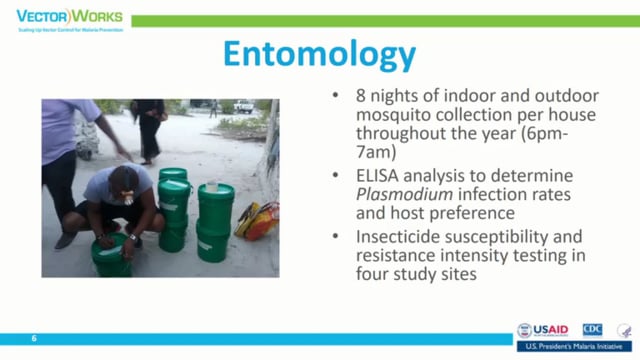Last Updated: 21/05/2019
Ongoing Malaria Transmission in Tanzania and Burkina Faso: Investigating the magnitude and drivers of persistent malaria
Objectives
The main aim of this study was to quantify and characterize existing ongoing Plasmodium transmission in communities where LLINs are already widely used, but where transmission still persists.
Specific objectives:
- To compare the level of ongoing malaria transmission that occurs outside dwellings at different times of night and indoors, in both high- and low-transmission settings.
- To quantify levels of pyrethroid insecticide resistance in the selected study sites and estimate its potential contribution to ongoing malaria transmission.
- To identify common human outdoor activities and environmental factors associated with ongoing malaria transmission in the different sites.
- To develop a draft guideline for assessing exposure to ongoing malaria transmission both indoors and outdoors, including peridomestic (in or around human homes) and non-peridomestic spaces in different settings.
Current vector control practices, such as long-lasting insecticide treated nets (LLINs) and indoor residual sprays (IRS) have contributed significantly to malaria control. As a result there has been a dramatic decrease in the global malaria burden in recent years, with 29% fewer deaths today compared to 2010, and a 21% reduction in incidence over the same period. But progress is now levelling off. In many settings, low-level ongoing transmission now persists even in areas where LLINs and IRS coverage already exceeds 80%.
This study involved:
- Surveillance of indoor and outdoor mosquito density, as well as resting mosquitoes using CDC light traps next to bed nets;
- Assessments of malaria vectors’ sporozoites rates (presence of Plasmodium in spore-like stage) and blood meal contents;
- Assessments of malaria vectors’ female parity (egg-laying) rates to approximate their age structures;
- Assessments of malaria vector susceptibility to insecticides commonly used in mosquito control;
- Surveillance of human behaviours in and around human homes (peridomestic) and in non-peridomestic settings;
- Observations of household characteristics and their relationships to mosquito density;
- Assessments of communities’ knowledge, attitudes and perceptions towards malaria transmission.


